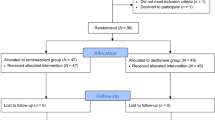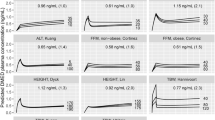Abstract
The aim of this study was to determine the minimum anesthetic concentration of isoflurane (MACISO) and sevoflurane (MACSEVO) and evaluate the cardiorespiratory changes induced by varying fractions of inspired oxygen (FiO2) in Magellanic penguins (Spheniscus magellanicus). Twenty adult penguins (3.53 ± 0.44 kg) of undetermined sex were used. Both MACISO (n = 9) and MACSEVO (n = 13) were established using an up-and-down design. Next, twelve mechanically ventilated penguins were maintained at 1 MACISO or 1 MACSEVO (n = 6 per group) with the FiO2 initially set at 1.0. Three FiO2 values (0.6, 0.4 and 0.2) were then held constant during anesthesia for 20 minutes each. Arterial blood samples were collected for gas analysis after the 20-minute period for each FiO2. Mean ± SD MACISO was 1.93 ± 0.10% and MACSEVO was 3.53 ± 0.13%. Other than heart rate at 0.6 FiO2 (86 ± 11 beats/minute in MACISO and 132 ± 37 beats/minute in MACSEVO; p = 0.041), no significant cardiorespiratory differences were detected between groups. In both groups, decreasing the FiO2 produced increased pH values and reduced partial pressures of carbon dioxide and bicarbonate. Partial pressures of oxygen (PaO2) gradually lowered from 1.0 FiO2 through 0.2 FiO2, though hypoxemia (PaO2 < 80 mmHg) occurred only with the latter FiO2. The MACISO and the MACSEVO for the Magellanic penguin fell within the upper range of reported avian MAC estimates. To prevent hypoxemia in healthy, mechanically ventilated, either isoflurane- or sevoflurane-anesthetized Magellanic penguins, a minimum FiO2 of 0.4 should be used.

Similar content being viewed by others
Data availability
No datasets were generated or analysed during the current study.
References
Abou-Madi N (2001) Avian anesthesia. Vet Clin North Am Exot Anim Pract 4:147–167. https://doi.org/10.1016/s1094-9194(17)30055-5
Aguado D, Benito J, Gómez IA (2011) Reduction of the minimum alveolar concentration of isoflurane in dogs using a constant rate of infusion of lidocaine-ketamine in combination with either morphine or fentanyl. Vet J 189:63–66. https://doi.org/10.1016/j.tvjl.2010.05.029
Aranake A, Mashour GA, Avidan MS (2013) Minimum alveolar concentration: ongoing relevance and clinical utility. Anesth 68:522–522. https://doi.org/10.1111/anae.12168
Bodley K, Schmitt TL (2014) Penguins. In: West G, Heard D, Caulkett N (eds) Zoo animal wildlife immobilization and anesthesia, 2nd edn. Wiley, Hoboken, pp 435–443
Botman J, Dugdale A, Gabriel F, Vandeweerd JM (2016a) Cardiorespiratory parameters in the awake pigeon and during anaesthesia with isoflurane. Vet Anaesth Analg 43:63–71. https://doi.org/10.1111/vaa.12262
Botman J, Dugdale A, Gabriel F, Vandeweerd JM (2016b) Anaesthesia with sevoflurane in pigeons: minimal anaesthetic concentration (MAC) determination and investigation of cardiorespiratory variables at 1 MAC. Vet Rec 178:1–6. https://doi.org/10.1136/vr.103654
Bradford C, Bronson E, Kintner L, Schultz D, Mcdonnell J (2008) Diagnosis and attempted surgical repair of hemivertebrae in an African penguin (Spheniscus demersus). J Avian Med Surg 22:331–335. https://doi.org/10.1647/2007-059.1
Chan FT, Chang GR, Wang HC, Hsu TH (2013) Anesthesia with isoflurane and sevoflurane in the crested serpent eagle (Spilornis cheela hoya): minimum anesthetic concentration, physiological effects, hematocrit, plasma chemistry and behavioral effects. J Vet Med Sci 75:1591–1600. https://doi.org/10.1292/jvms.13-0161
Curro TG, Brunson DB, Paul-Murphy J (1994) Determination of the ED50 of isoflurane and evaluation of the isoflurane-sparing effect of butorphanol in cockatoos (Cacatua spp.). Vet Surg 23:429–433. https://doi.org/10.1111/j.1532-950x.1994.tb00502.x
Dixon WJ (1965) The up-and-down method for small samples. Am Statist Assoc J 60:967–978. https://doi.org/10.2307/2283398
Dobbs P, Moittié S, Liptovszky M (2021) Avian anaesthesia related mortality and the associated risk factors in a UK zoological collection. Vet Anesth Analg 48:922–929. https://doi.org/10.1016/j.vaa.2021.04.012
Dutra GHP, Araujo GS, Silva ANE, Nascimento CL, Carregaro AB (2019) Venous and arterial acid-base analysis of Magellanic penguins (Spheniscus magellanicus), awake and anesthetized by isoflurane. J Zoo Wildl Med 50:262–265. https://doi.org/10.1638/2018-0083
Eger EI, Saidman LJ, Brandstater B (1965) Minimum alveolar anesthetic concentration: a standard of anesthetic potency. Anesthesiology 26:756–763
Escobar A, Valadão CAA, Brosnan RJ, Denicol AC, Flôres FN, Thiesen R, Coelho CMM (2012) Effect of butorphanol on the minimum anesthetic concentration for sevoflurane in guineafowl (Numida meleagris). Am J Vet Res 73:183–188. https://doi.org/10.2460/ajvr.73.2.183
Escobar A, Rocha RW, Pypendop BH, Filho DZ, Sousa SS, Valadão CAA (2016) Effects of methadone on the minimum anesthetic concentration of isoflurane, and its effects on heart rate, blood pressure and ventilation during isoflurane anesthesia in hens (Gallus gallus domesticus). PLoS One 11:1–12. https://doi.org/10.1371/journal.pone.0152546
Escobar A, Rocha RW, Midon M, Almeida RM, Filho DZ, Werther K (2017) Effects of tramadol on the minimum anesthetic concentration of isoflurane in white-eyed parakeets (Psittacara leucophthalmus). J Zoo Wildl Med 48:380–387. https://doi.org/10.1371/10.1638/2016-0180R1.1
Gallo L, Vanstreels RET, Cook RA, Karesh WB, Uhart M (2019) Hematology, plasma biochemistry, and trace element reference values for free-ranging adult Magellanic penguins (Spheniscus magellanicus). Polar Biol 42:733–742. https://doi.org/10.1007/s00300-019-02467-7
García-Borboroglu P, Boersma PD, Ruoppolo V et al (2010) Magellanic penguin mortality in 2008 along the SW Atlantic coast. Mar Pollut Bull 60:1652–1657. https://doi.org/10.1016/j.marpolbul.2010.07.006
Gill F, Donsker K, Rasmussen P (2023) IOC World Bird List. https://www.worldbirdnames.org/new/classification/orders-of-birds-draft/. Accessed 10 Nov 2023
Hawkins MG, Pascoe PJ, Knych HKD, Drazenovich TL, Kass PH, Guzman DSM (2018) Effects of three fentanyl plasma concentrations on the minimum alveolar concentration of isoflurane in Hispaniolan Amazon parrots (Amazona ventralis). Am J Vet Res 79:600–605. https://doi.org/10.2460/ajvr.79.6.600
Hopper K, Powell LL (2013) Basics of mechanical ventilation for dogs and cats. Vet Clin North Am Small Anim Pract 43:955–969. https://doi.org/10.1016/j.cvsm.2013.03.009
Joyner PH, Jones MP, Ward D, Gompf RE, Zagaya N, Sleeman JM (2008) Induction and recovery characteristics and cardiopulmonary effects of sevoflurane and isoflurane in bald eagles. Am J Vet Res 69:13–22. https://doi.org/10.2460/ajvr.69.1.13
Jung WS, Ko M, Cho HK, Kang BJ, Choi JH, Chung JY (2017) A case of endoscopic retrieval of a long bamboo stick from a Humboldt penguin (Spheniscus humboldti). J Vet Med Sci 79:448–451. https://doi.org/10.1292/jvms.16-0416
Kim YK, Lee SS, Suh EH et al (2011) Minimum anesthetic concentration and cardiovascular dose-response relationship of isoflurane in cinereous vultures (Aegypius monachus). J Zoo Wildl Med 42:499–503. https://doi.org/10.1638/2010-0151.1
Ludders JW (2017) Comparative anesthesia and analgesia of birds. In: Grimm KA, Lamont LA, Tranquilli WJ, Greene SA, Robertson SA (eds) Veterinary anesthesia and analgesia, 5th edn. Wiley, Hoboken, pp 800–816
Lukasik VM, Gentz EJ, Erb HN, Ludders JW, Scarlett JM (1997) Cardiopulmonary effects of propofol anesthesia in chickens (Gallus gallus domesticus). J Avian Med Surg 11:93–97
Meir JU, Ponganis PJ (2009) High-affinity hemoglobin and blood oxygen saturation in diving emperor penguins. J Expo Biol 212:3330–3338. https://doi.org/10.1242/jeb.033761
Meir JU, Stockard TK, Williams CL, Ponganis KV, Ponganis PJ (2008) Heart rate regulation and extreme bradycardia in diving emperor penguins. J Expo Biol 211:1169–1179. https://doi.org/10.1242/jeb.013235
Mercado JA, Larsen RS, Wack RF, Pypendop BH (2008) Minimum anesthetic concentration of isoflurane in captive thick-billed parrots (Rhynchopsitta pachyrhyncha). Am J Vet Res 69:189–194. https://doi.org/10.2460/ajvr.69.2.189
Mutoh T, Kojima K, Takao K, Nishimura R, Sasaki N (2001) Comparison of sevoflurane with isoflurane for rapid mask induction in midazolam and butorphanol-sedated dogs. J Vet Med A Physiol Pathol Clin Med 48:223–230. https://doi.org/10.1046/j.1439-0442.2001.00350.x
Naganobu K, Mitsuyoshi H (2000) Dose-related cardiovascular effects of isoflurane in chickens during controlled ventilation. J Vet Med Sci 62:435–437. https://doi.org/10.1292/jvms.62.435
Naganobu K, Fujisawa Y, Ohde H, Matsuda Y, Sonoda T, Ogawa H (2000) Determination of the minimum anesthetic concentration and cardiovascular dose response for sevoflurane in chickens during controlled ventilation. Vet Surg 29:102–105. https://doi.org/10.1111/j.1532-950x.2000.00102.x
Nevitt BN, Langan JN, Adkesson MJ, Mitchell MA, Henzler M, Drees R (2014) Comparison of air sac volume, lung volume, and lung densities determined by use of computed tomography in conscious and anesthetized Humboldt penguins (Spheniscus humboldti) positioned in ventral, dorsal, and right lateral recumbency. Am J Vet Res 75:739–745. https://doi.org/10.2460/ajvr.75.8.739
Paul M, Fisher DM (2001) Are estimates of MAC reliable? Anesthesiology 95:1362–1370. https://doi.org/10.1097/00000542-200112000-00014
Pavez JC, Hawkins MG, Pascoe PJ, Knych HKD, Kass PH (2011) Effect of fentanyl target-controlled infusions on isoflurane minimum anaesthetic concentration and cardiovascular function in red-tailed hawks (Buteo jamaicensis). Vet Anaesth Analg 38:344–351. https://doi.org/10.1111/j.1467-2995.2011.00627.x
Phair KA, Larsen R, Wack RF, Shilo-Benjamini Y, Pypendop BH (2012) Determination of the minimum anesthetic concentration of sevoflurane in thick-billed parrots (Rhynchopsitta pachyrhyncha). Am J Vet Res 73:1350–1355. https://doi.org/10.2460/ajvr.73.9.1350
Ponganis PJ, Kooyman GL, Starke LN, Kooyman CA, Kooyman TG (1997) Post-dive blood lactate concentrations in emperor penguins, Aptenodytes forsteri. J Exp Biol 200:1623–1626. https://doi.org/10.1242/jeb.200.11.1623
Reed R, Doherty T (2018) Minimum alveolar concentration: key concepts and a review of its pharmacological reduction in dogs. Res Vet Sci 117:266–270. https://doi.org/10.1016/j.rvsc.2018.01.004
Romero P, Restitutti F, McGill N, Hoey S, Bennett RC (2023) Anaesthetic management and complications of a Humboldt penguin (Spheniscus humboldti) undergoing diagnostic imaging. Ir Vet J 76:1–10. https://doi.org/10.1186/s13620-023-00256-7
Sala JE, Wilson RP, Frere E, Quintana F (2014) Flexible foraging for finding fish: variable diving patterns in Magellanic penguins Spheniscus magellanicus from different colonies. J Ornith 155:1–17. https://doi.org/10.1007/s10336-014-1065-5
Silva-Filho RP, Ruoppolo V (2014) Sphenisciformes (Pinguim). In: Cubas JL, Silva ZS, Catão-Dias JC (eds) Tratado de Animais Selvagens: Medicina Veterinária, 2nd edn. Roca, São Paulo, pp 384–416
Staffieri F, Franchini D, Carella GL et al (2007) Computed tomographic analysis of the effects of two inspired oxygen concentrations on pulmonary aeration in anesthetized and mechanically ventilated dogs. Am J Vet Res 68:925–931. https://doi.org/10.2460/ajvr.68.9.925
Steffey EP, Khursheed RM, Brosnan RJ (2015) Inhalation anesthetics. In: Grimm KA, Lamont LA, Tranquilli WJ, Greene SA, Robertson AS (eds) Veterinary anesthesia and analgesia: the fifth edition of Lumb and Jones. Wiley, Hoboken, pp 297–331
Wilson RP, Simeone A, Luna-Jorquera G et al (2003) Patterns of respiration in diving penguins: is the last gasp an inspired tactic? J Expo Biol 206:1751–1763. https://doi.org/10.1242/jeb.00341
Wilson RP, Scolaro A, Quintana F (2004) To the bottom of the heart: cloacal movement as an index of cardiac frequency, respiration and digestive evacuation in penguins. Mar Biol 144:813–827. https://doi.org/10.1007/s00227-003-1247-9
Funding
This study was funded by grant no. 13/19796-0, São Paulo Research Foundation (FAPESP).
Author information
Authors and Affiliations
Contributions
All authors contributed to the study conception and design. Fieldwork was performed by ANES, GHPD, GSMA and ABC. Data analyses were performed by ANES, AAJ, TFB and ABC. The first draft of the manuscript was written by AAJ and ABC and all authors commented on previous versions of the manuscript. ABC reviewed the versions of the manuscript. All authors reviewed and approved the final version of the manuscript.
Corresponding author
Ethics declarations
Ethics statement
The current study was approved by the Committee of Ethics in Animal Experimentation of the Faculty of Animal Science and Food Engineering, University of São Paulo (protocol No. 14.1.87.74.8), and by the Brazilian Biodiversity Information and Authorization System (SISBIO No. 41254–1).
Consent to participate
Not applicable.
Consent to publish
Not applicable.
Competing interests
The authors declare no competing interests.
Additional information
Publisher’s Note
Springer Nature remains neutral with regard to jurisdictional claims in published maps and institutional affiliations.
Rights and permissions
Springer Nature or its licensor (e.g. a society or other partner) holds exclusive rights to this article under a publishing agreement with the author(s) or other rightsholder(s); author self-archiving of the accepted manuscript version of this article is solely governed by the terms of such publishing agreement and applicable law.
About this article
Cite this article
da Silva, A.N.E., Dutra, G.H.P., Justo, A.A. et al. Minimum anesthetic concentration of isoflurane and sevoflurane and cardiorespiratory effects of varying inspired oxygen fractions in Magellanic penguins (Spheniscus magellanicus). Vet Res Commun (2024). https://doi.org/10.1007/s11259-024-10336-w
Received:
Accepted:
Published:
DOI: https://doi.org/10.1007/s11259-024-10336-w




